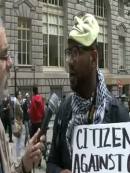Enter The RED Shirts : A Documentary Project.
Added on Feb 23, 2011
Length: 08:14 | Comments: 0
For over seven years, from 2004- 2010, I documented and witnessed the red shirt’s political struggle on Rajadamneon Road, the road famous for having been hosted Thai political contexts etched on it for a long period of time. The road is also a landmark of political symbol, where it hosted many political struggles and egalitarianism between the people, on one hand, and the state on the other. The data and footage collection sprang from my personal interests to document historical events, without event knowing what the future would bring or if there would be the “red shirts” entering the scene on the political struggling on the road in Thailand. Since the coup d'état in 2006, the Thai society has in embedded with deep and wide spreading political conflicts. Ideological differences and conflicts reached micro levels in households, friends and families all over Thailand. Two distinct camps of people, the yellow shirts and the red shirts demanded political rights, albeit they sought different political goals. They were similar and shared reflections of the past political struggles of the crackdown of alleged “communist” students by the state in 1976. I documented both camps’ activities on the field and found that the topic is very relevant to the interests of the Thai and foreign communities, who are interested, yet still confused about the politics on the road and the historical event of Thailand. The incident later unfurled to a political violence in mid 2010, when 91 people were killed officially and several thousands people were injured. The red shirts were most effected. The violence made the front pages and headline news globally. Despite the news coverage, the Thais and foreigners did not have a clear picture of the details of the incident. This documentary aimed to provided in-depth incidents under a theme “diving to the red shirt’s world.” It wanted to shed the light why we need to understand the red shirts. The Thai society has ambiguous opinions about the red shirts, thus I want to portray why the red shirts think and decide to fight these ways. I use many viewpoints of people that inspired the red shirts on well-rounded basis and based my story on an “understanding” that the people should respect and tolerate the differences among them. The understanding, in this regards, is vital to the Thai society, because the society is moving to a massive ideological changes, through the political struggles on the roads. This time, it is rapidly sinking to the breaking point after the dispersal of the protests in the capital city. “Revolution” was often frequently spoken of (in underground red shirts radio). This time it was not a “reform” like previous times. The turning point of the Thai politic is approaching in an unseen changes. The documentary will also document the effects on the red shirts whose rights was violated in many forms and contexts. The issues were inextricable with the red shirts. After the protest dispersal in the mid 2010, the red shirts have shift their strategies, standpoints and adjust their struggles in details. There are many interesting cases that the red shirts’ human rights were violated in remote areas such as the Northern part of the North-eastern region of Thailand (data from lawyers and volunteer human rights activists.) The understanding among the people from the basis of sharing the same national space and as human beings is one of an alternative and an answer why we have to understand the red shirts more than the present and more significantly. I used black and white footage in the documentary to signify that we can look at them neutrally, naturally and instinctively as human being with some values on their own, regardless of being defined by colors during their struggles. Finally, their spirits cannot be defined or be delusive by the colors the distinct them apart. The black and white footage highlight “fundamental instincts” because the human complexities are indivisible and people cannot be simply categorized politically, unlike the spatial arrangement in the modern thoughts. We, as the people have many colors, despite the Thai society now tends to superficially categorize people by colors without much thoughts. As people cannot converse with trust like previous days, I only hope it would be better if people could be more color blinded temporarily, then, they could see the true “spirits” of each person through their facial expressions and the eyes and realize a common humanity.
Channels: Hobbies & Interests
Related Videos
People & Politics Project: Peace & Freedom Campaign Commercial
by vshareViews: 709 | Comments: 0
I think people are finally waking up
by millermusicViews: 884 | Comments: 0
Stephen Colbert Drew Carey Garry Trudeau Political Humor and Campaigning Part 6 2004
by vshareViews: 1332 | Comments: 0
Newfoundland Tourism Advertisement- People Places
by vshareViews: 926 | Comments: 0
Celebs Shine at People's Choice Awards
by vshareViews: 1062 | Comments: 0
Power of the People
by vshareViews: 860 | Comments: 0
THE ULTIMATE DRUNK PEOPLE COMPILATION VIDEO EVER
by vshareViews: 1186 | Comments: 0
No Getting Through To Some People
by vshareViews: 941 | Comments: 0
mobifriends - meeting new people and having fun - Is free
by vshareViews: 901 | Comments: 0




 vshare
vshare

















